Strategic Management Approaches: Linear, Stakeholder, and Dynamic
VerifiedAdded on 2020/04/07
|19
|4399
|141
Report
AI Summary
This report provides a detailed overview of strategic management, exploring different approaches used by organizations to achieve their goals. It begins by examining the conventional linear model, discussing its benefits such as resource control and clear milestones, as well as its inflexibility and limitations in adapting to change. The report then delves into the stakeholder approach, emphasizing the importance of considering the interests of all stakeholders for long-term success, while acknowledging potential challenges like subjective assessments and conflicts of interest. The dynamic capability approach is also analyzed, highlighting its focus on integrating and reconfiguring internal and external competencies to adapt to changing environments. The report also touches upon the sustainability approach, which focuses on aligning strategies with environmental conditions. Overall, the report offers a comparative analysis of these approaches, providing insights into their advantages and disadvantages to help managers make informed decisions.
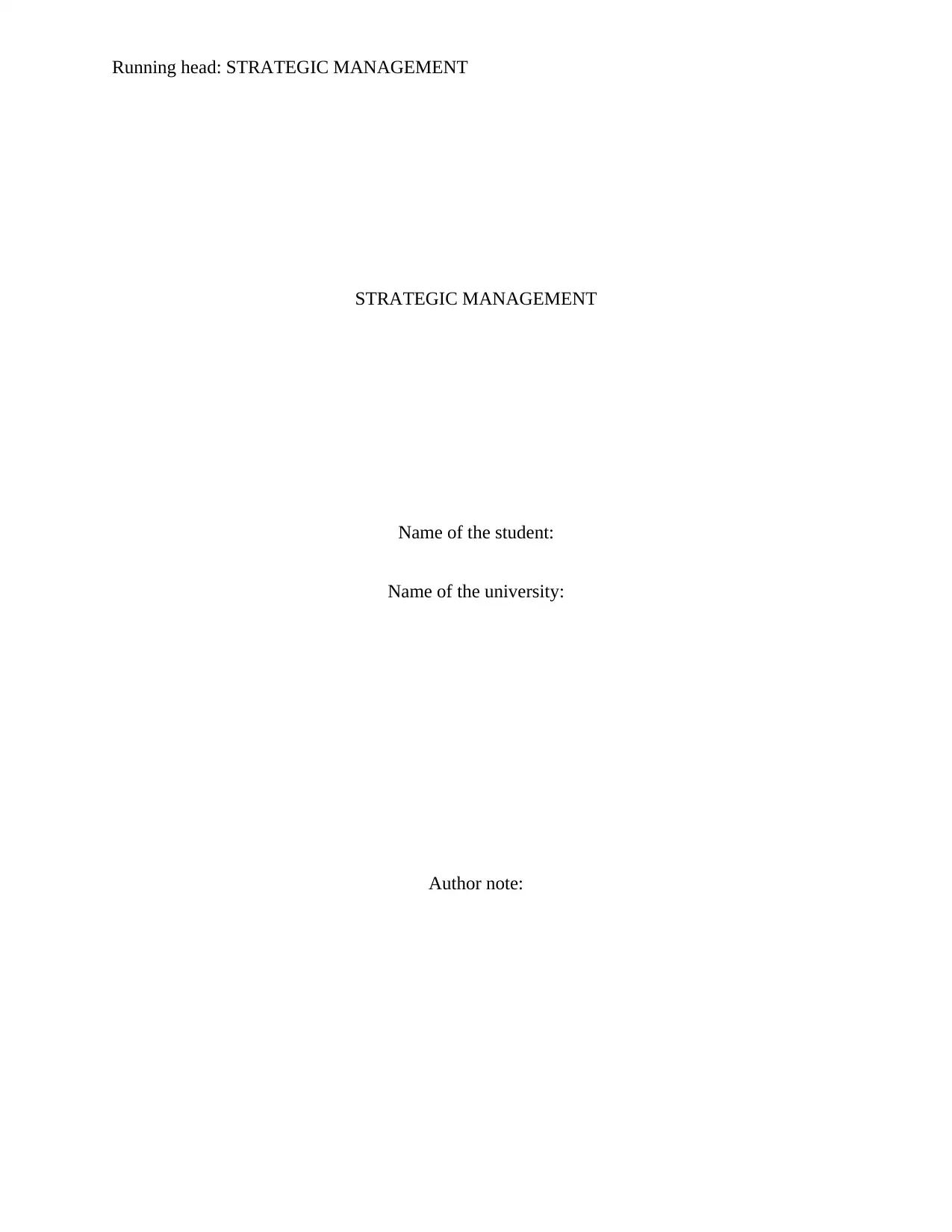
Running head: STRATEGIC MANAGEMENT
STRATEGIC MANAGEMENT
Name of the student:
Name of the university:
Author note:
STRATEGIC MANAGEMENT
Name of the student:
Name of the university:
Author note:
Paraphrase This Document
Need a fresh take? Get an instant paraphrase of this document with our AI Paraphraser
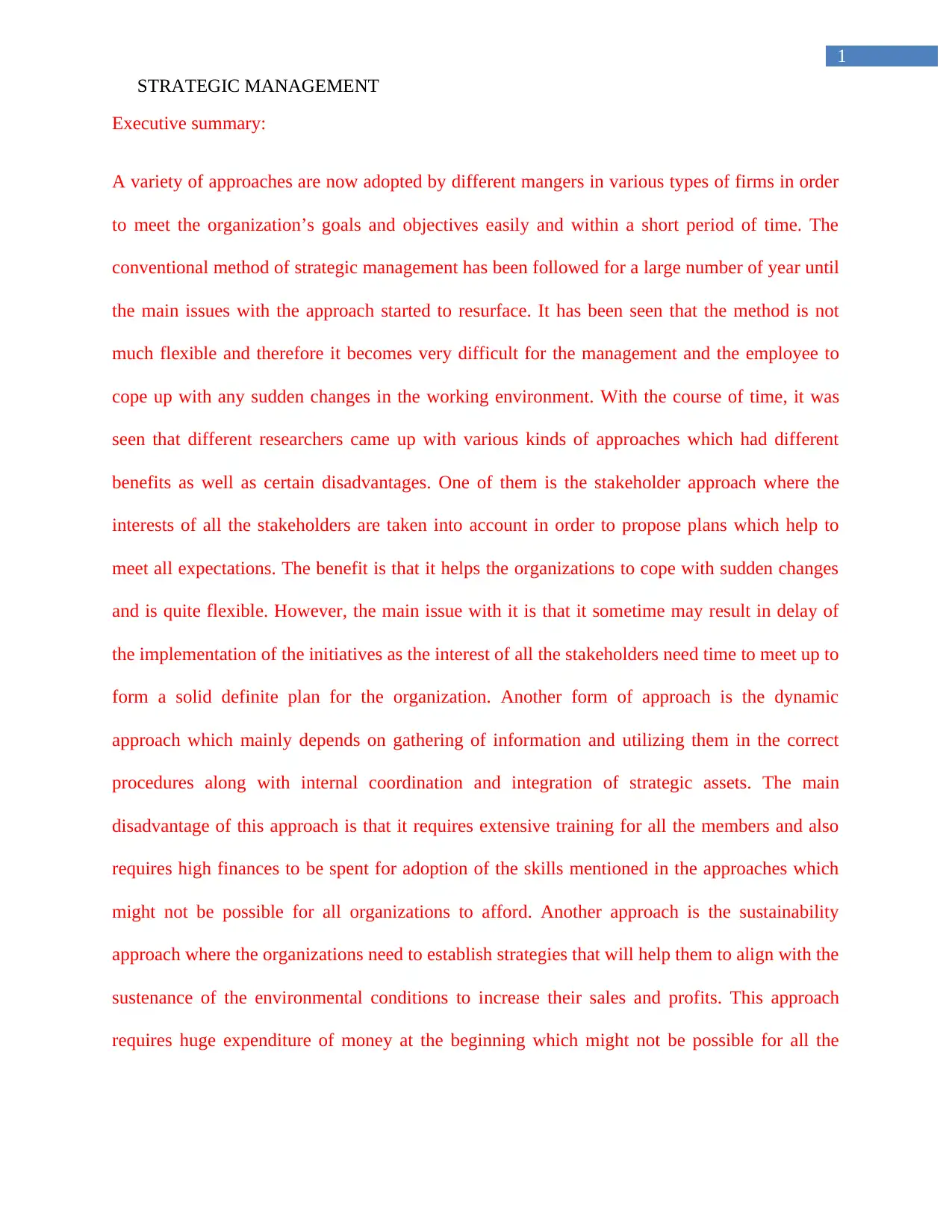
1
STRATEGIC MANAGEMENT
Executive summary:
A variety of approaches are now adopted by different mangers in various types of firms in order
to meet the organization’s goals and objectives easily and within a short period of time. The
conventional method of strategic management has been followed for a large number of year until
the main issues with the approach started to resurface. It has been seen that the method is not
much flexible and therefore it becomes very difficult for the management and the employee to
cope up with any sudden changes in the working environment. With the course of time, it was
seen that different researchers came up with various kinds of approaches which had different
benefits as well as certain disadvantages. One of them is the stakeholder approach where the
interests of all the stakeholders are taken into account in order to propose plans which help to
meet all expectations. The benefit is that it helps the organizations to cope with sudden changes
and is quite flexible. However, the main issue with it is that it sometime may result in delay of
the implementation of the initiatives as the interest of all the stakeholders need time to meet up to
form a solid definite plan for the organization. Another form of approach is the dynamic
approach which mainly depends on gathering of information and utilizing them in the correct
procedures along with internal coordination and integration of strategic assets. The main
disadvantage of this approach is that it requires extensive training for all the members and also
requires high finances to be spent for adoption of the skills mentioned in the approaches which
might not be possible for all organizations to afford. Another approach is the sustainability
approach where the organizations need to establish strategies that will help them to align with the
sustenance of the environmental conditions to increase their sales and profits. This approach
requires huge expenditure of money at the beginning which might not be possible for all the
STRATEGIC MANAGEMENT
Executive summary:
A variety of approaches are now adopted by different mangers in various types of firms in order
to meet the organization’s goals and objectives easily and within a short period of time. The
conventional method of strategic management has been followed for a large number of year until
the main issues with the approach started to resurface. It has been seen that the method is not
much flexible and therefore it becomes very difficult for the management and the employee to
cope up with any sudden changes in the working environment. With the course of time, it was
seen that different researchers came up with various kinds of approaches which had different
benefits as well as certain disadvantages. One of them is the stakeholder approach where the
interests of all the stakeholders are taken into account in order to propose plans which help to
meet all expectations. The benefit is that it helps the organizations to cope with sudden changes
and is quite flexible. However, the main issue with it is that it sometime may result in delay of
the implementation of the initiatives as the interest of all the stakeholders need time to meet up to
form a solid definite plan for the organization. Another form of approach is the dynamic
approach which mainly depends on gathering of information and utilizing them in the correct
procedures along with internal coordination and integration of strategic assets. The main
disadvantage of this approach is that it requires extensive training for all the members and also
requires high finances to be spent for adoption of the skills mentioned in the approaches which
might not be possible for all organizations to afford. Another approach is the sustainability
approach where the organizations need to establish strategies that will help them to align with the
sustenance of the environmental conditions to increase their sales and profits. This approach
requires huge expenditure of money at the beginning which might not be possible for all the
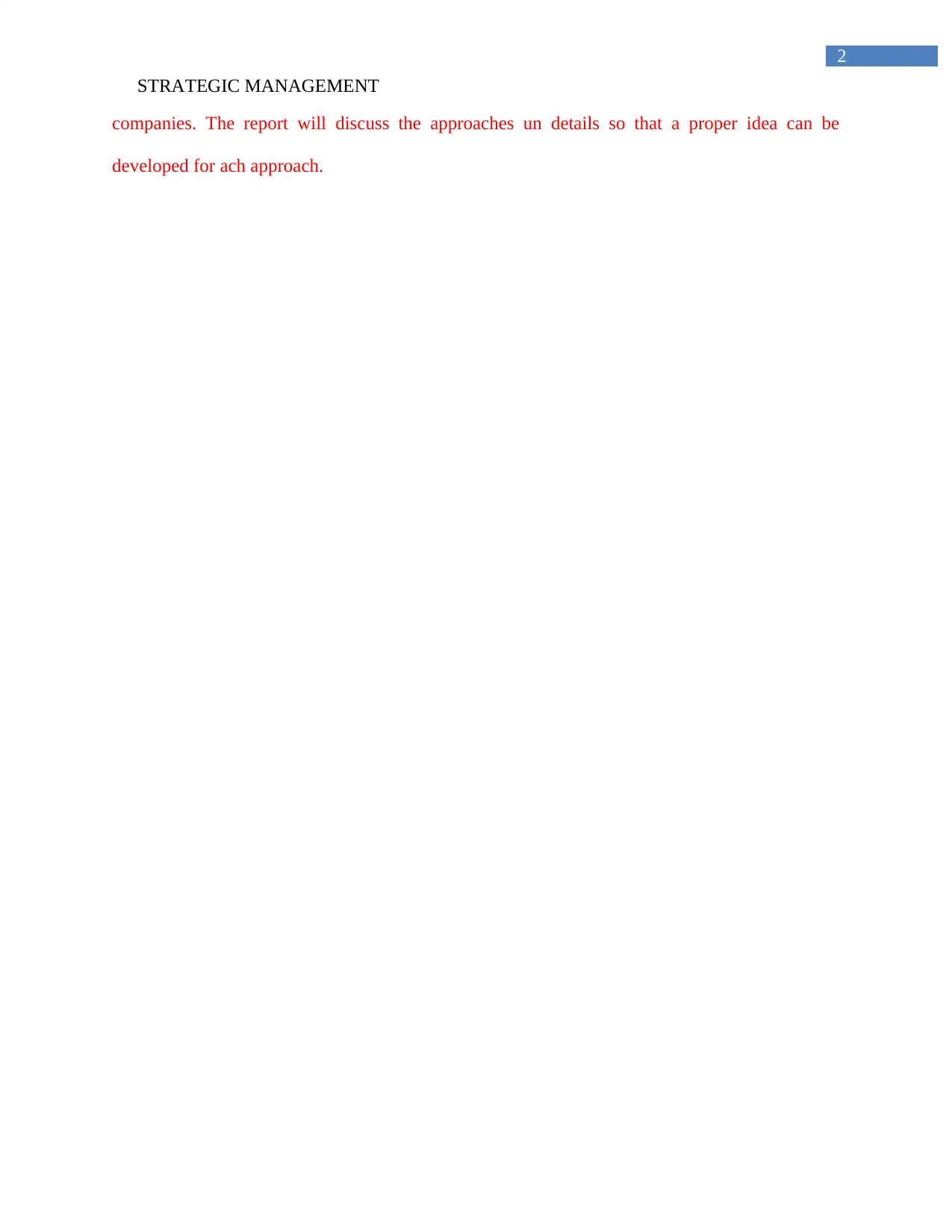
2
STRATEGIC MANAGEMENT
companies. The report will discuss the approaches un details so that a proper idea can be
developed for ach approach.
STRATEGIC MANAGEMENT
companies. The report will discuss the approaches un details so that a proper idea can be
developed for ach approach.
⊘ This is a preview!⊘
Do you want full access?
Subscribe today to unlock all pages.

Trusted by 1+ million students worldwide
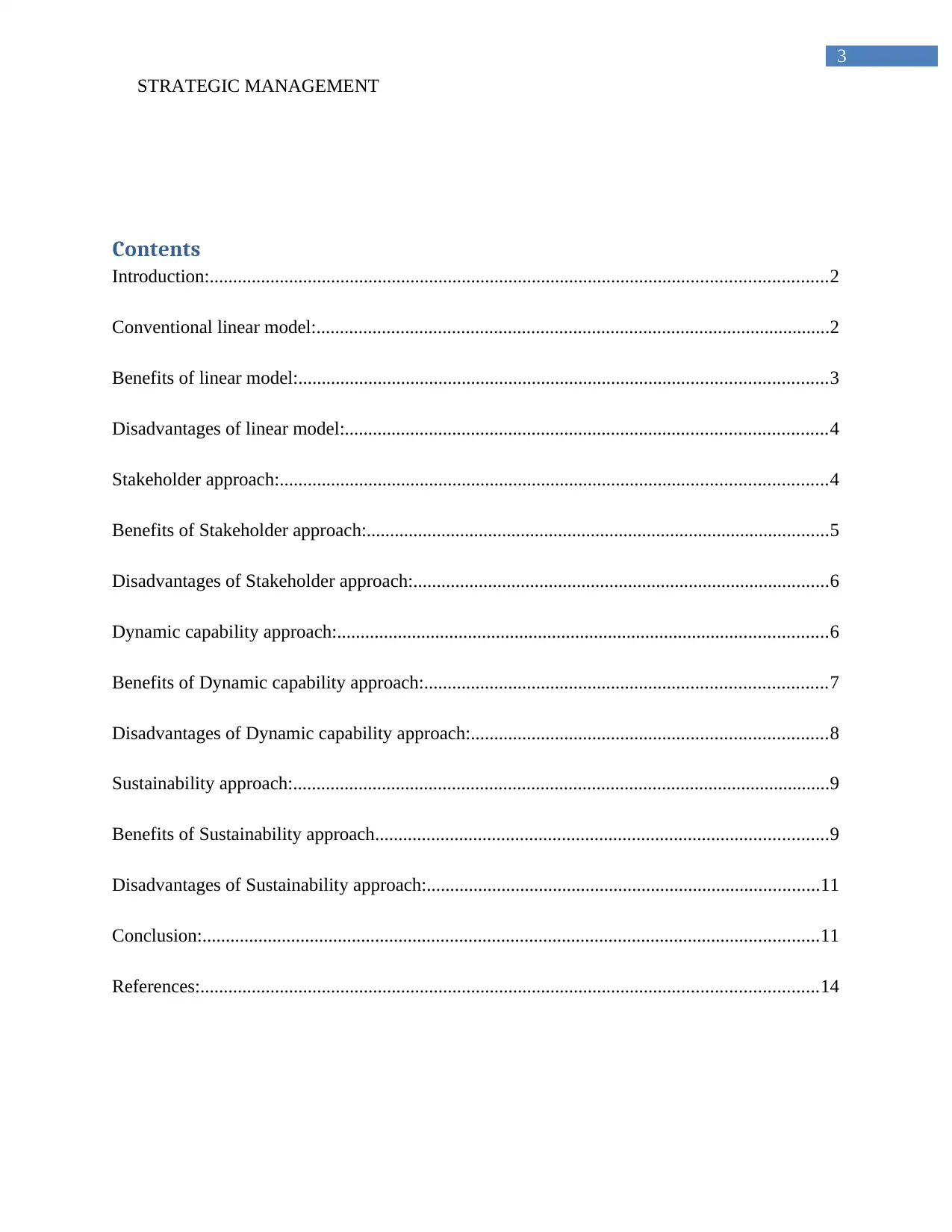
3
STRATEGIC MANAGEMENT
Contents
Introduction:....................................................................................................................................2
Conventional linear model:..............................................................................................................2
Benefits of linear model:.................................................................................................................3
Disadvantages of linear model:.......................................................................................................4
Stakeholder approach:.....................................................................................................................4
Benefits of Stakeholder approach:...................................................................................................5
Disadvantages of Stakeholder approach:.........................................................................................6
Dynamic capability approach:.........................................................................................................6
Benefits of Dynamic capability approach:......................................................................................7
Disadvantages of Dynamic capability approach:............................................................................8
Sustainability approach:...................................................................................................................9
Benefits of Sustainability approach.................................................................................................9
Disadvantages of Sustainability approach:....................................................................................11
Conclusion:....................................................................................................................................11
References:....................................................................................................................................14
STRATEGIC MANAGEMENT
Contents
Introduction:....................................................................................................................................2
Conventional linear model:..............................................................................................................2
Benefits of linear model:.................................................................................................................3
Disadvantages of linear model:.......................................................................................................4
Stakeholder approach:.....................................................................................................................4
Benefits of Stakeholder approach:...................................................................................................5
Disadvantages of Stakeholder approach:.........................................................................................6
Dynamic capability approach:.........................................................................................................6
Benefits of Dynamic capability approach:......................................................................................7
Disadvantages of Dynamic capability approach:............................................................................8
Sustainability approach:...................................................................................................................9
Benefits of Sustainability approach.................................................................................................9
Disadvantages of Sustainability approach:....................................................................................11
Conclusion:....................................................................................................................................11
References:....................................................................................................................................14
Paraphrase This Document
Need a fresh take? Get an instant paraphrase of this document with our AI Paraphraser
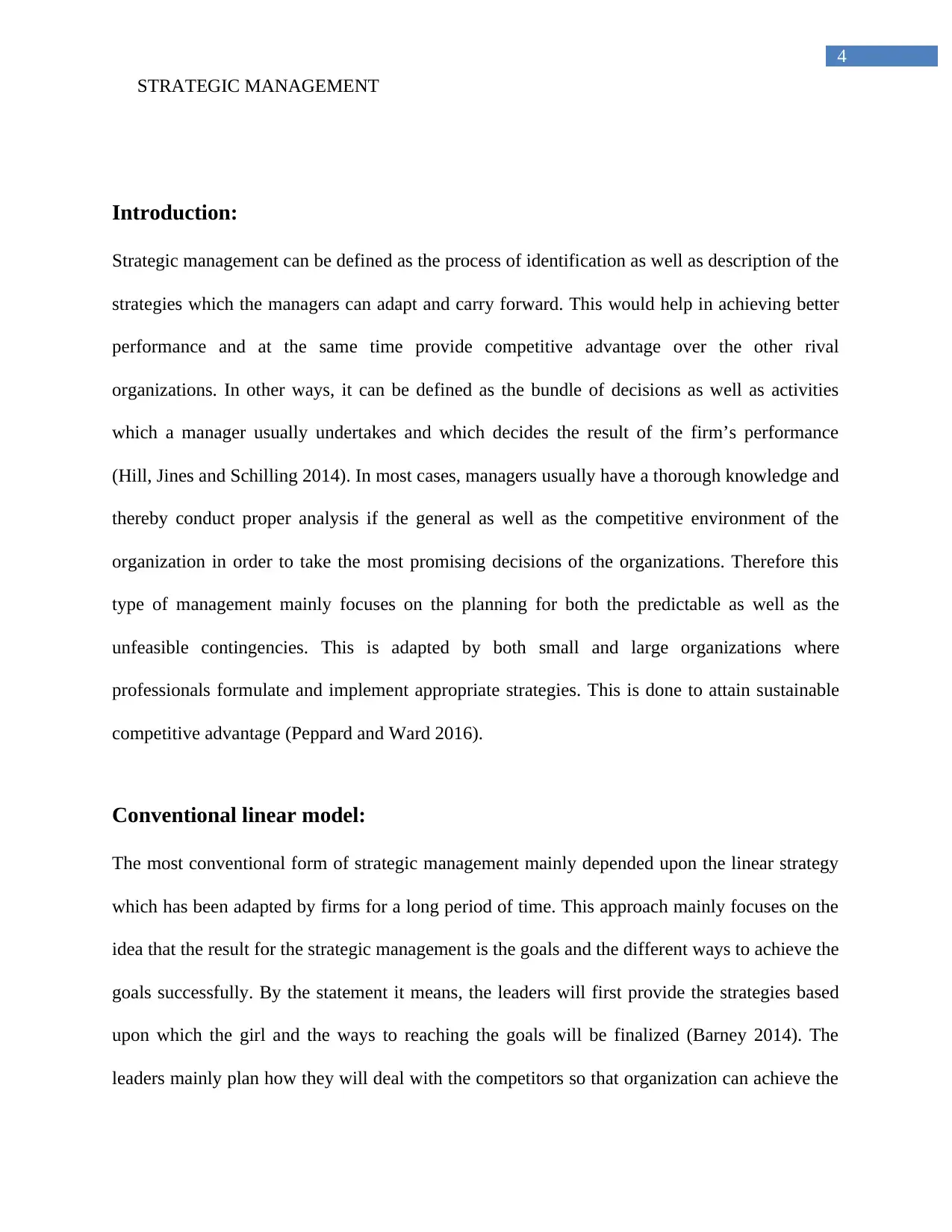
4
STRATEGIC MANAGEMENT
Introduction:
Strategic management can be defined as the process of identification as well as description of the
strategies which the managers can adapt and carry forward. This would help in achieving better
performance and at the same time provide competitive advantage over the other rival
organizations. In other ways, it can be defined as the bundle of decisions as well as activities
which a manager usually undertakes and which decides the result of the firm’s performance
(Hill, Jines and Schilling 2014). In most cases, managers usually have a thorough knowledge and
thereby conduct proper analysis if the general as well as the competitive environment of the
organization in order to take the most promising decisions of the organizations. Therefore this
type of management mainly focuses on the planning for both the predictable as well as the
unfeasible contingencies. This is adapted by both small and large organizations where
professionals formulate and implement appropriate strategies. This is done to attain sustainable
competitive advantage (Peppard and Ward 2016).
Conventional linear model:
The most conventional form of strategic management mainly depended upon the linear strategy
which has been adapted by firms for a long period of time. This approach mainly focuses on the
idea that the result for the strategic management is the goals and the different ways to achieve the
goals successfully. By the statement it means, the leaders will first provide the strategies based
upon which the girl and the ways to reaching the goals will be finalized (Barney 2014). The
leaders mainly plan how they will deal with the competitors so that organization can achieve the
STRATEGIC MANAGEMENT
Introduction:
Strategic management can be defined as the process of identification as well as description of the
strategies which the managers can adapt and carry forward. This would help in achieving better
performance and at the same time provide competitive advantage over the other rival
organizations. In other ways, it can be defined as the bundle of decisions as well as activities
which a manager usually undertakes and which decides the result of the firm’s performance
(Hill, Jines and Schilling 2014). In most cases, managers usually have a thorough knowledge and
thereby conduct proper analysis if the general as well as the competitive environment of the
organization in order to take the most promising decisions of the organizations. Therefore this
type of management mainly focuses on the planning for both the predictable as well as the
unfeasible contingencies. This is adapted by both small and large organizations where
professionals formulate and implement appropriate strategies. This is done to attain sustainable
competitive advantage (Peppard and Ward 2016).
Conventional linear model:
The most conventional form of strategic management mainly depended upon the linear strategy
which has been adapted by firms for a long period of time. This approach mainly focuses on the
idea that the result for the strategic management is the goals and the different ways to achieve the
goals successfully. By the statement it means, the leaders will first provide the strategies based
upon which the girl and the ways to reaching the goals will be finalized (Barney 2014). The
leaders mainly plan how they will deal with the competitors so that organization can achieve the
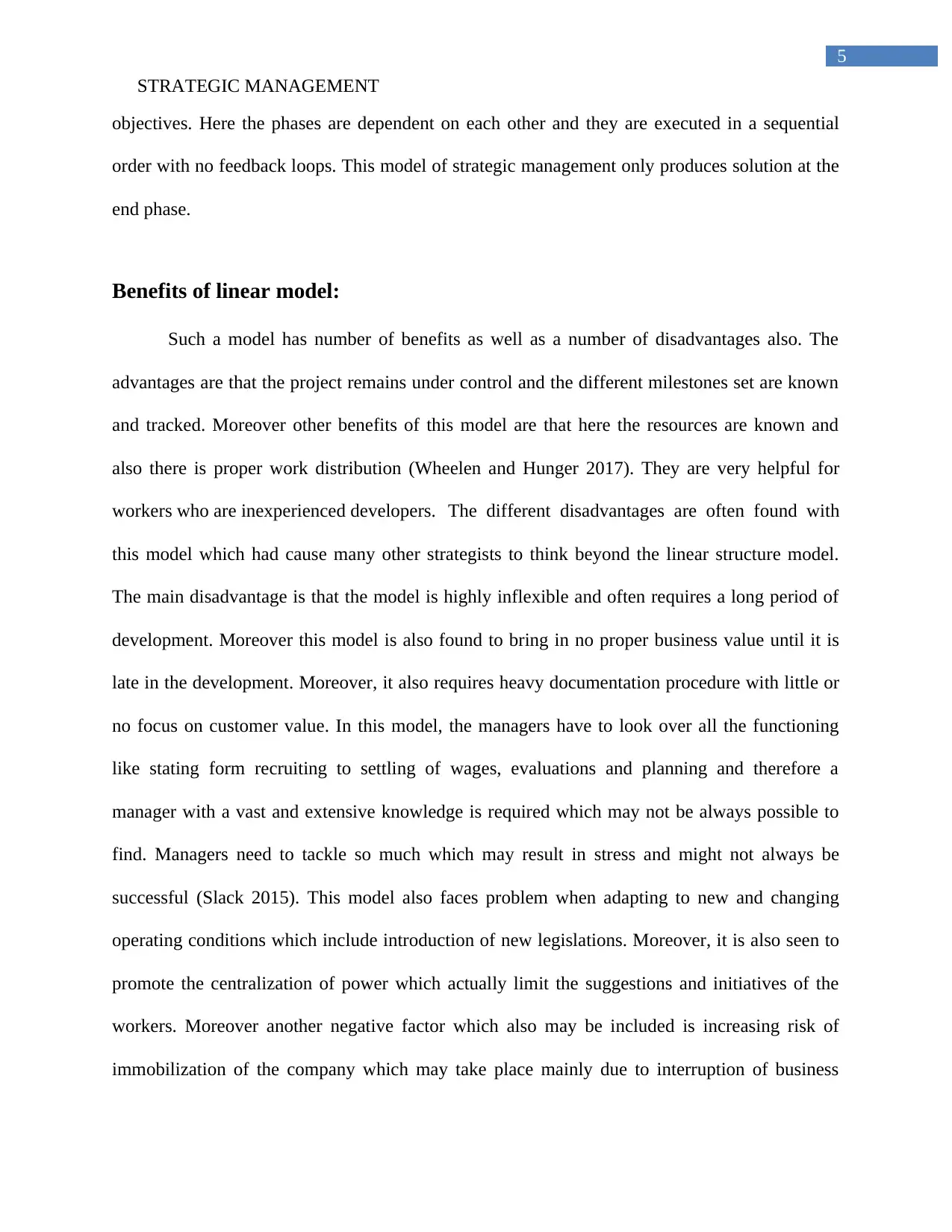
5
STRATEGIC MANAGEMENT
objectives. Here the phases are dependent on each other and they are executed in a sequential
order with no feedback loops. This model of strategic management only produces solution at the
end phase.
Benefits of linear model:
Such a model has number of benefits as well as a number of disadvantages also. The
advantages are that the project remains under control and the different milestones set are known
and tracked. Moreover other benefits of this model are that here the resources are known and
also there is proper work distribution (Wheelen and Hunger 2017). They are very helpful for
workers who are inexperienced developers. The different disadvantages are often found with
this model which had cause many other strategists to think beyond the linear structure model.
The main disadvantage is that the model is highly inflexible and often requires a long period of
development. Moreover this model is also found to bring in no proper business value until it is
late in the development. Moreover, it also requires heavy documentation procedure with little or
no focus on customer value. In this model, the managers have to look over all the functioning
like stating form recruiting to settling of wages, evaluations and planning and therefore a
manager with a vast and extensive knowledge is required which may not be always possible to
find. Managers need to tackle so much which may result in stress and might not always be
successful (Slack 2015). This model also faces problem when adapting to new and changing
operating conditions which include introduction of new legislations. Moreover, it is also seen to
promote the centralization of power which actually limit the suggestions and initiatives of the
workers. Moreover another negative factor which also may be included is increasing risk of
immobilization of the company which may take place mainly due to interruption of business
STRATEGIC MANAGEMENT
objectives. Here the phases are dependent on each other and they are executed in a sequential
order with no feedback loops. This model of strategic management only produces solution at the
end phase.
Benefits of linear model:
Such a model has number of benefits as well as a number of disadvantages also. The
advantages are that the project remains under control and the different milestones set are known
and tracked. Moreover other benefits of this model are that here the resources are known and
also there is proper work distribution (Wheelen and Hunger 2017). They are very helpful for
workers who are inexperienced developers. The different disadvantages are often found with
this model which had cause many other strategists to think beyond the linear structure model.
The main disadvantage is that the model is highly inflexible and often requires a long period of
development. Moreover this model is also found to bring in no proper business value until it is
late in the development. Moreover, it also requires heavy documentation procedure with little or
no focus on customer value. In this model, the managers have to look over all the functioning
like stating form recruiting to settling of wages, evaluations and planning and therefore a
manager with a vast and extensive knowledge is required which may not be always possible to
find. Managers need to tackle so much which may result in stress and might not always be
successful (Slack 2015). This model also faces problem when adapting to new and changing
operating conditions which include introduction of new legislations. Moreover, it is also seen to
promote the centralization of power which actually limit the suggestions and initiatives of the
workers. Moreover another negative factor which also may be included is increasing risk of
immobilization of the company which may take place mainly due to interruption of business
⊘ This is a preview!⊘
Do you want full access?
Subscribe today to unlock all pages.

Trusted by 1+ million students worldwide
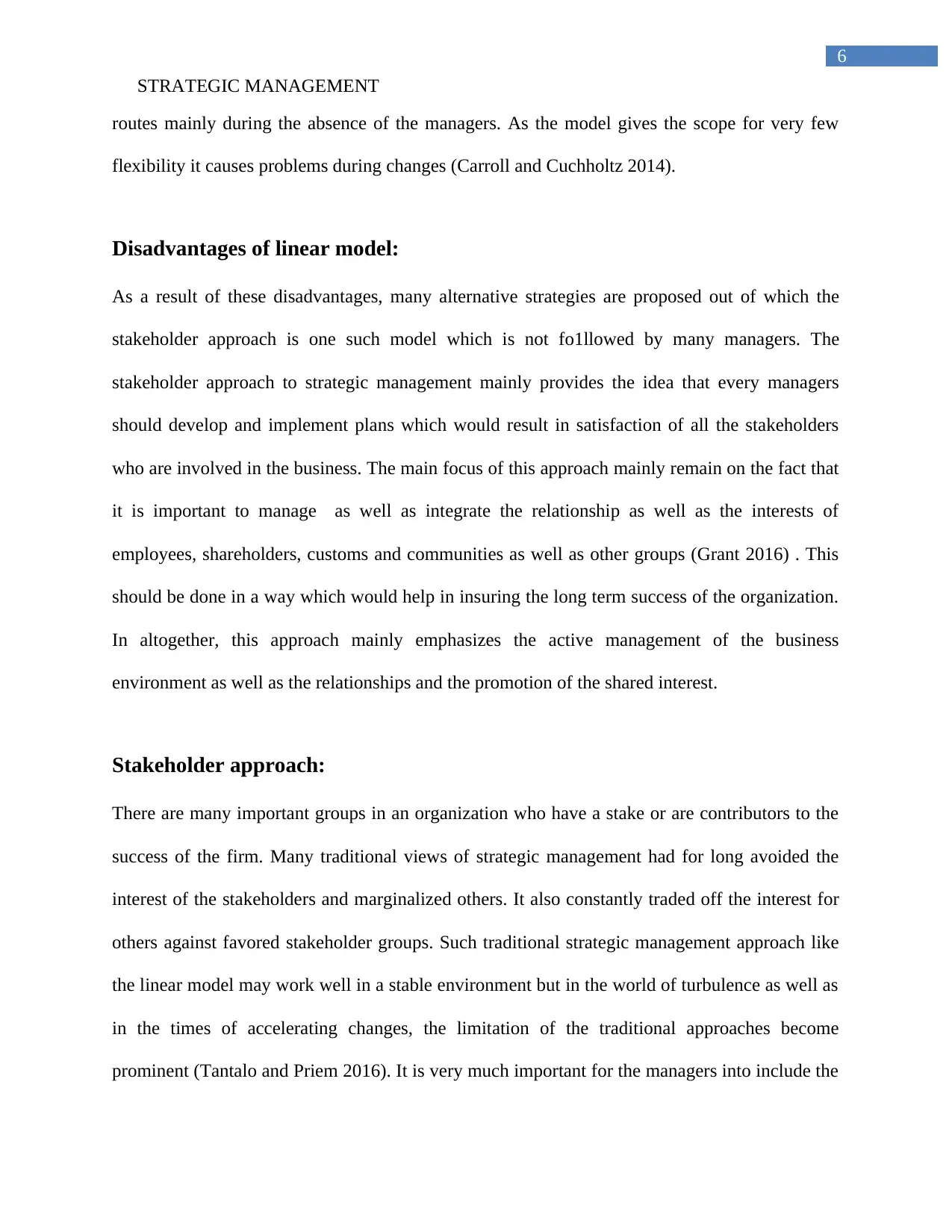
6
STRATEGIC MANAGEMENT
routes mainly during the absence of the managers. As the model gives the scope for very few
flexibility it causes problems during changes (Carroll and Cuchholtz 2014).
Disadvantages of linear model:
As a result of these disadvantages, many alternative strategies are proposed out of which the
stakeholder approach is one such model which is not fo1llowed by many managers. The
stakeholder approach to strategic management mainly provides the idea that every managers
should develop and implement plans which would result in satisfaction of all the stakeholders
who are involved in the business. The main focus of this approach mainly remain on the fact that
it is important to manage as well as integrate the relationship as well as the interests of
employees, shareholders, customs and communities as well as other groups (Grant 2016) . This
should be done in a way which would help in insuring the long term success of the organization.
In altogether, this approach mainly emphasizes the active management of the business
environment as well as the relationships and the promotion of the shared interest.
Stakeholder approach:
There are many important groups in an organization who have a stake or are contributors to the
success of the firm. Many traditional views of strategic management had for long avoided the
interest of the stakeholders and marginalized others. It also constantly traded off the interest for
others against favored stakeholder groups. Such traditional strategic management approach like
the linear model may work well in a stable environment but in the world of turbulence as well as
in the times of accelerating changes, the limitation of the traditional approaches become
prominent (Tantalo and Priem 2016). It is very much important for the managers into include the
STRATEGIC MANAGEMENT
routes mainly during the absence of the managers. As the model gives the scope for very few
flexibility it causes problems during changes (Carroll and Cuchholtz 2014).
Disadvantages of linear model:
As a result of these disadvantages, many alternative strategies are proposed out of which the
stakeholder approach is one such model which is not fo1llowed by many managers. The
stakeholder approach to strategic management mainly provides the idea that every managers
should develop and implement plans which would result in satisfaction of all the stakeholders
who are involved in the business. The main focus of this approach mainly remain on the fact that
it is important to manage as well as integrate the relationship as well as the interests of
employees, shareholders, customs and communities as well as other groups (Grant 2016) . This
should be done in a way which would help in insuring the long term success of the organization.
In altogether, this approach mainly emphasizes the active management of the business
environment as well as the relationships and the promotion of the shared interest.
Stakeholder approach:
There are many important groups in an organization who have a stake or are contributors to the
success of the firm. Many traditional views of strategic management had for long avoided the
interest of the stakeholders and marginalized others. It also constantly traded off the interest for
others against favored stakeholder groups. Such traditional strategic management approach like
the linear model may work well in a stable environment but in the world of turbulence as well as
in the times of accelerating changes, the limitation of the traditional approaches become
prominent (Tantalo and Priem 2016). It is very much important for the managers into include the
Paraphrase This Document
Need a fresh take? Get an instant paraphrase of this document with our AI Paraphraser
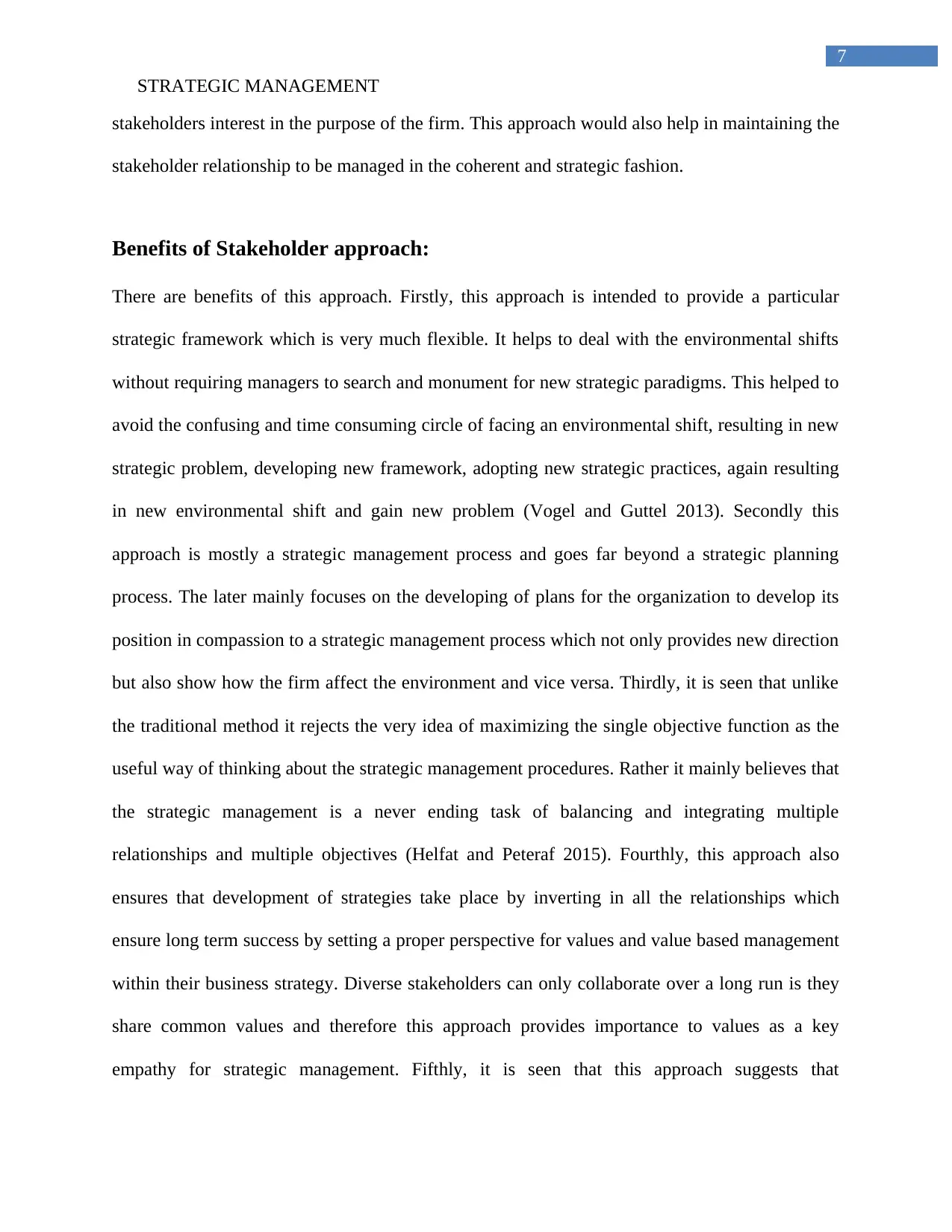
7
STRATEGIC MANAGEMENT
stakeholders interest in the purpose of the firm. This approach would also help in maintaining the
stakeholder relationship to be managed in the coherent and strategic fashion.
Benefits of Stakeholder approach:
There are benefits of this approach. Firstly, this approach is intended to provide a particular
strategic framework which is very much flexible. It helps to deal with the environmental shifts
without requiring managers to search and monument for new strategic paradigms. This helped to
avoid the confusing and time consuming circle of facing an environmental shift, resulting in new
strategic problem, developing new framework, adopting new strategic practices, again resulting
in new environmental shift and gain new problem (Vogel and Guttel 2013). Secondly this
approach is mostly a strategic management process and goes far beyond a strategic planning
process. The later mainly focuses on the developing of plans for the organization to develop its
position in compassion to a strategic management process which not only provides new direction
but also show how the firm affect the environment and vice versa. Thirdly, it is seen that unlike
the traditional method it rejects the very idea of maximizing the single objective function as the
useful way of thinking about the strategic management procedures. Rather it mainly believes that
the strategic management is a never ending task of balancing and integrating multiple
relationships and multiple objectives (Helfat and Peteraf 2015). Fourthly, this approach also
ensures that development of strategies take place by inverting in all the relationships which
ensure long term success by setting a proper perspective for values and value based management
within their business strategy. Diverse stakeholders can only collaborate over a long run is they
share common values and therefore this approach provides importance to values as a key
empathy for strategic management. Fifthly, it is seen that this approach suggests that
STRATEGIC MANAGEMENT
stakeholders interest in the purpose of the firm. This approach would also help in maintaining the
stakeholder relationship to be managed in the coherent and strategic fashion.
Benefits of Stakeholder approach:
There are benefits of this approach. Firstly, this approach is intended to provide a particular
strategic framework which is very much flexible. It helps to deal with the environmental shifts
without requiring managers to search and monument for new strategic paradigms. This helped to
avoid the confusing and time consuming circle of facing an environmental shift, resulting in new
strategic problem, developing new framework, adopting new strategic practices, again resulting
in new environmental shift and gain new problem (Vogel and Guttel 2013). Secondly this
approach is mostly a strategic management process and goes far beyond a strategic planning
process. The later mainly focuses on the developing of plans for the organization to develop its
position in compassion to a strategic management process which not only provides new direction
but also show how the firm affect the environment and vice versa. Thirdly, it is seen that unlike
the traditional method it rejects the very idea of maximizing the single objective function as the
useful way of thinking about the strategic management procedures. Rather it mainly believes that
the strategic management is a never ending task of balancing and integrating multiple
relationships and multiple objectives (Helfat and Peteraf 2015). Fourthly, this approach also
ensures that development of strategies take place by inverting in all the relationships which
ensure long term success by setting a proper perspective for values and value based management
within their business strategy. Diverse stakeholders can only collaborate over a long run is they
share common values and therefore this approach provides importance to values as a key
empathy for strategic management. Fifthly, it is seen that this approach suggests that
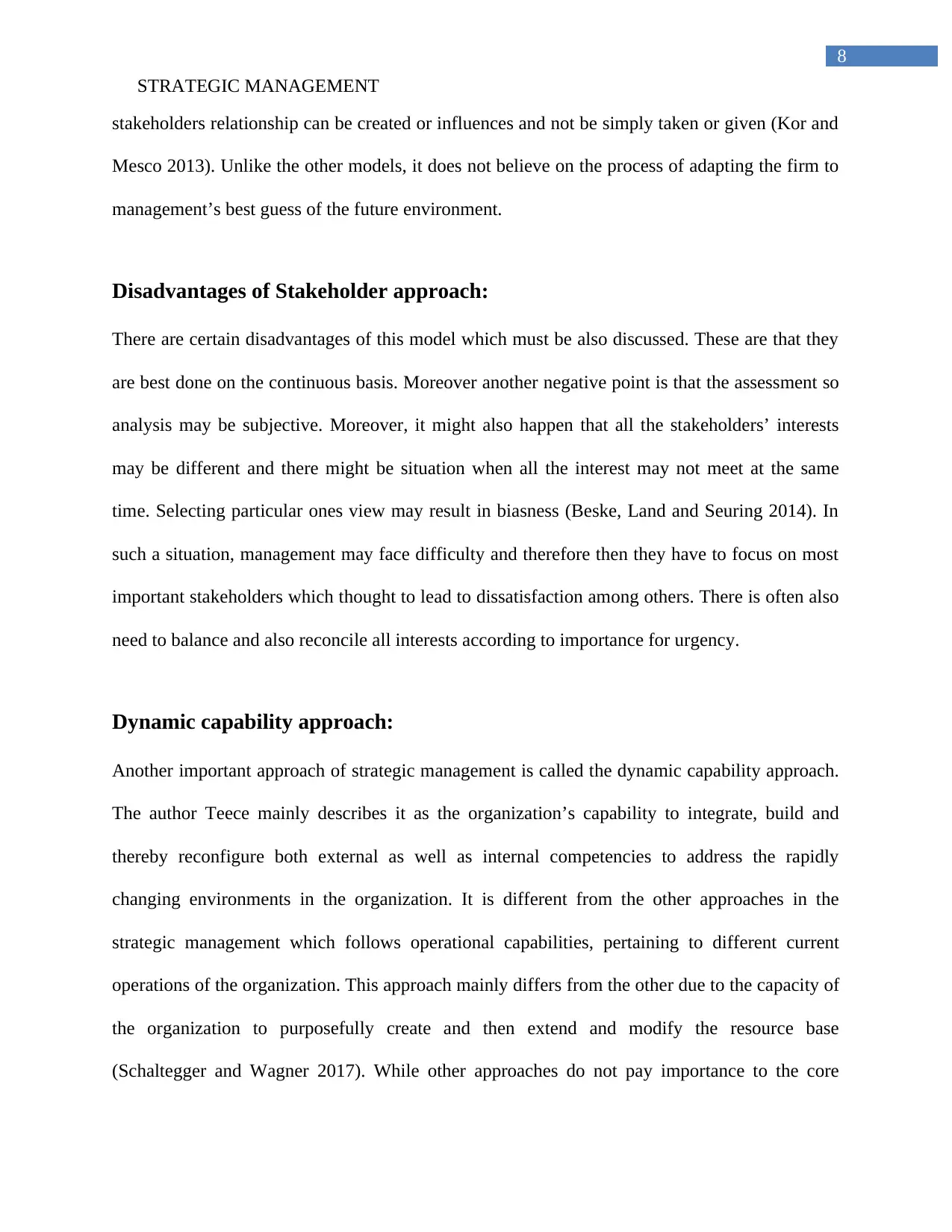
8
STRATEGIC MANAGEMENT
stakeholders relationship can be created or influences and not be simply taken or given (Kor and
Mesco 2013). Unlike the other models, it does not believe on the process of adapting the firm to
management’s best guess of the future environment.
Disadvantages of Stakeholder approach:
There are certain disadvantages of this model which must be also discussed. These are that they
are best done on the continuous basis. Moreover another negative point is that the assessment so
analysis may be subjective. Moreover, it might also happen that all the stakeholders’ interests
may be different and there might be situation when all the interest may not meet at the same
time. Selecting particular ones view may result in biasness (Beske, Land and Seuring 2014). In
such a situation, management may face difficulty and therefore then they have to focus on most
important stakeholders which thought to lead to dissatisfaction among others. There is often also
need to balance and also reconcile all interests according to importance for urgency.
Dynamic capability approach:
Another important approach of strategic management is called the dynamic capability approach.
The author Teece mainly describes it as the organization’s capability to integrate, build and
thereby reconfigure both external as well as internal competencies to address the rapidly
changing environments in the organization. It is different from the other approaches in the
strategic management which follows operational capabilities, pertaining to different current
operations of the organization. This approach mainly differs from the other due to the capacity of
the organization to purposefully create and then extend and modify the resource base
(Schaltegger and Wagner 2017). While other approaches do not pay importance to the core
STRATEGIC MANAGEMENT
stakeholders relationship can be created or influences and not be simply taken or given (Kor and
Mesco 2013). Unlike the other models, it does not believe on the process of adapting the firm to
management’s best guess of the future environment.
Disadvantages of Stakeholder approach:
There are certain disadvantages of this model which must be also discussed. These are that they
are best done on the continuous basis. Moreover another negative point is that the assessment so
analysis may be subjective. Moreover, it might also happen that all the stakeholders’ interests
may be different and there might be situation when all the interest may not meet at the same
time. Selecting particular ones view may result in biasness (Beske, Land and Seuring 2014). In
such a situation, management may face difficulty and therefore then they have to focus on most
important stakeholders which thought to lead to dissatisfaction among others. There is often also
need to balance and also reconcile all interests according to importance for urgency.
Dynamic capability approach:
Another important approach of strategic management is called the dynamic capability approach.
The author Teece mainly describes it as the organization’s capability to integrate, build and
thereby reconfigure both external as well as internal competencies to address the rapidly
changing environments in the organization. It is different from the other approaches in the
strategic management which follows operational capabilities, pertaining to different current
operations of the organization. This approach mainly differs from the other due to the capacity of
the organization to purposefully create and then extend and modify the resource base
(Schaltegger and Wagner 2017). While other approaches do not pay importance to the core
⊘ This is a preview!⊘
Do you want full access?
Subscribe today to unlock all pages.

Trusted by 1+ million students worldwide
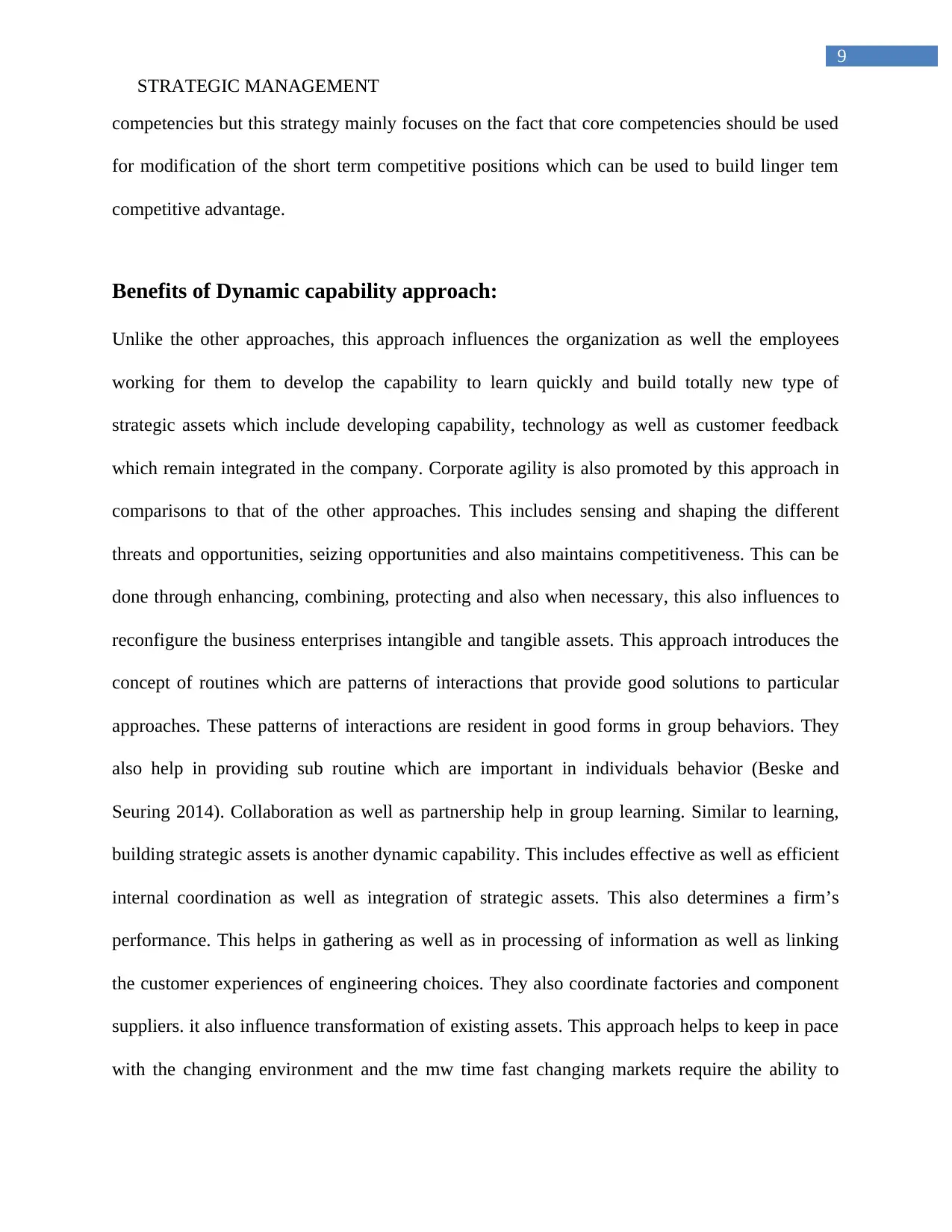
9
STRATEGIC MANAGEMENT
competencies but this strategy mainly focuses on the fact that core competencies should be used
for modification of the short term competitive positions which can be used to build linger tem
competitive advantage.
Benefits of Dynamic capability approach:
Unlike the other approaches, this approach influences the organization as well the employees
working for them to develop the capability to learn quickly and build totally new type of
strategic assets which include developing capability, technology as well as customer feedback
which remain integrated in the company. Corporate agility is also promoted by this approach in
comparisons to that of the other approaches. This includes sensing and shaping the different
threats and opportunities, seizing opportunities and also maintains competitiveness. This can be
done through enhancing, combining, protecting and also when necessary, this also influences to
reconfigure the business enterprises intangible and tangible assets. This approach introduces the
concept of routines which are patterns of interactions that provide good solutions to particular
approaches. These patterns of interactions are resident in good forms in group behaviors. They
also help in providing sub routine which are important in individuals behavior (Beske and
Seuring 2014). Collaboration as well as partnership help in group learning. Similar to learning,
building strategic assets is another dynamic capability. This includes effective as well as efficient
internal coordination as well as integration of strategic assets. This also determines a firm’s
performance. This helps in gathering as well as in processing of information as well as linking
the customer experiences of engineering choices. They also coordinate factories and component
suppliers. it also influence transformation of existing assets. This approach helps to keep in pace
with the changing environment and the mw time fast changing markets require the ability to
STRATEGIC MANAGEMENT
competencies but this strategy mainly focuses on the fact that core competencies should be used
for modification of the short term competitive positions which can be used to build linger tem
competitive advantage.
Benefits of Dynamic capability approach:
Unlike the other approaches, this approach influences the organization as well the employees
working for them to develop the capability to learn quickly and build totally new type of
strategic assets which include developing capability, technology as well as customer feedback
which remain integrated in the company. Corporate agility is also promoted by this approach in
comparisons to that of the other approaches. This includes sensing and shaping the different
threats and opportunities, seizing opportunities and also maintains competitiveness. This can be
done through enhancing, combining, protecting and also when necessary, this also influences to
reconfigure the business enterprises intangible and tangible assets. This approach introduces the
concept of routines which are patterns of interactions that provide good solutions to particular
approaches. These patterns of interactions are resident in good forms in group behaviors. They
also help in providing sub routine which are important in individuals behavior (Beske and
Seuring 2014). Collaboration as well as partnership help in group learning. Similar to learning,
building strategic assets is another dynamic capability. This includes effective as well as efficient
internal coordination as well as integration of strategic assets. This also determines a firm’s
performance. This helps in gathering as well as in processing of information as well as linking
the customer experiences of engineering choices. They also coordinate factories and component
suppliers. it also influence transformation of existing assets. This approach helps to keep in pace
with the changing environment and the mw time fast changing markets require the ability to
Paraphrase This Document
Need a fresh take? Get an instant paraphrase of this document with our AI Paraphraser
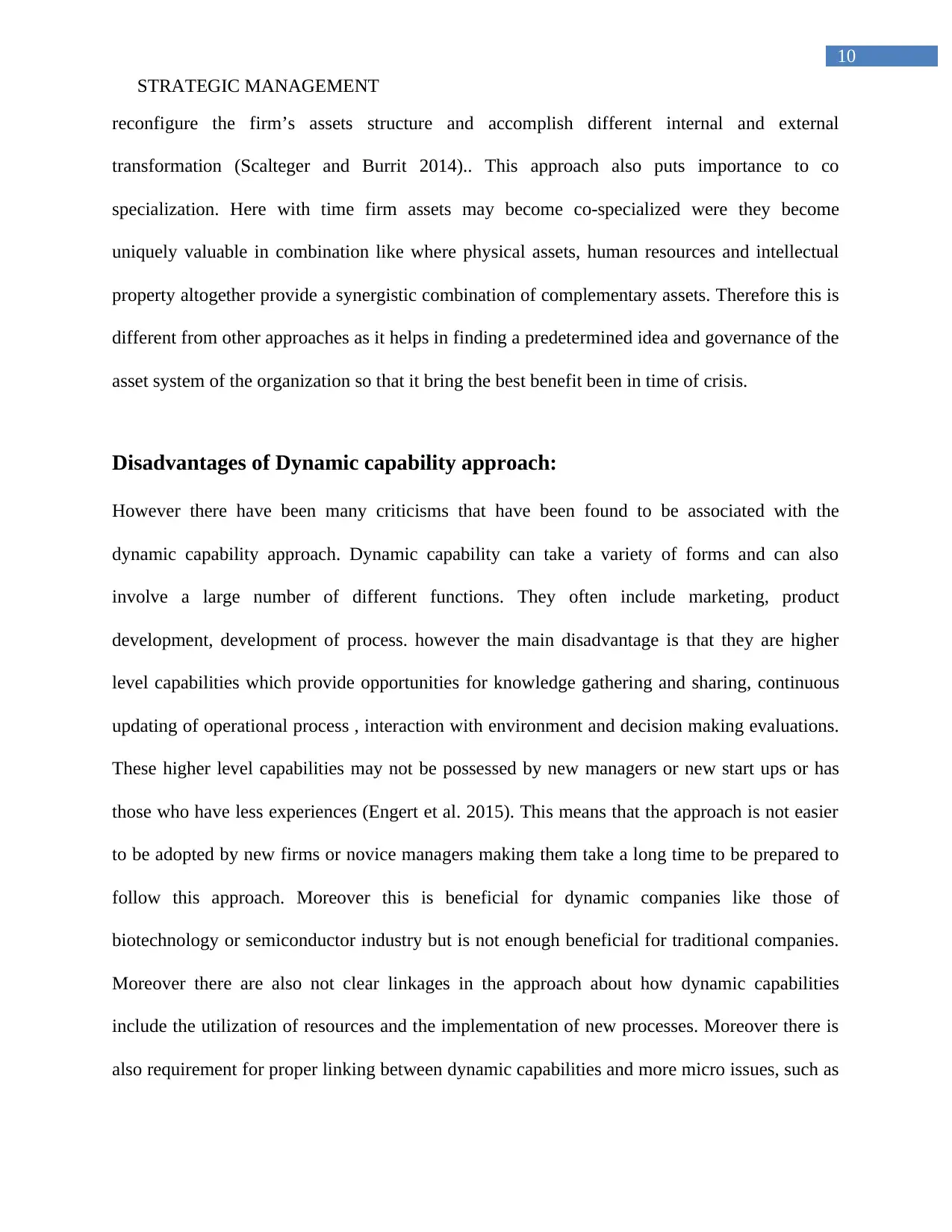
10
STRATEGIC MANAGEMENT
reconfigure the firm’s assets structure and accomplish different internal and external
transformation (Scalteger and Burrit 2014).. This approach also puts importance to co
specialization. Here with time firm assets may become co-specialized were they become
uniquely valuable in combination like where physical assets, human resources and intellectual
property altogether provide a synergistic combination of complementary assets. Therefore this is
different from other approaches as it helps in finding a predetermined idea and governance of the
asset system of the organization so that it bring the best benefit been in time of crisis.
Disadvantages of Dynamic capability approach:
However there have been many criticisms that have been found to be associated with the
dynamic capability approach. Dynamic capability can take a variety of forms and can also
involve a large number of different functions. They often include marketing, product
development, development of process. however the main disadvantage is that they are higher
level capabilities which provide opportunities for knowledge gathering and sharing, continuous
updating of operational process , interaction with environment and decision making evaluations.
These higher level capabilities may not be possessed by new managers or new start ups or has
those who have less experiences (Engert et al. 2015). This means that the approach is not easier
to be adopted by new firms or novice managers making them take a long time to be prepared to
follow this approach. Moreover this is beneficial for dynamic companies like those of
biotechnology or semiconductor industry but is not enough beneficial for traditional companies.
Moreover there are also not clear linkages in the approach about how dynamic capabilities
include the utilization of resources and the implementation of new processes. Moreover there is
also requirement for proper linking between dynamic capabilities and more micro issues, such as
STRATEGIC MANAGEMENT
reconfigure the firm’s assets structure and accomplish different internal and external
transformation (Scalteger and Burrit 2014).. This approach also puts importance to co
specialization. Here with time firm assets may become co-specialized were they become
uniquely valuable in combination like where physical assets, human resources and intellectual
property altogether provide a synergistic combination of complementary assets. Therefore this is
different from other approaches as it helps in finding a predetermined idea and governance of the
asset system of the organization so that it bring the best benefit been in time of crisis.
Disadvantages of Dynamic capability approach:
However there have been many criticisms that have been found to be associated with the
dynamic capability approach. Dynamic capability can take a variety of forms and can also
involve a large number of different functions. They often include marketing, product
development, development of process. however the main disadvantage is that they are higher
level capabilities which provide opportunities for knowledge gathering and sharing, continuous
updating of operational process , interaction with environment and decision making evaluations.
These higher level capabilities may not be possessed by new managers or new start ups or has
those who have less experiences (Engert et al. 2015). This means that the approach is not easier
to be adopted by new firms or novice managers making them take a long time to be prepared to
follow this approach. Moreover this is beneficial for dynamic companies like those of
biotechnology or semiconductor industry but is not enough beneficial for traditional companies.
Moreover there are also not clear linkages in the approach about how dynamic capabilities
include the utilization of resources and the implementation of new processes. Moreover there is
also requirement for proper linking between dynamic capabilities and more micro issues, such as
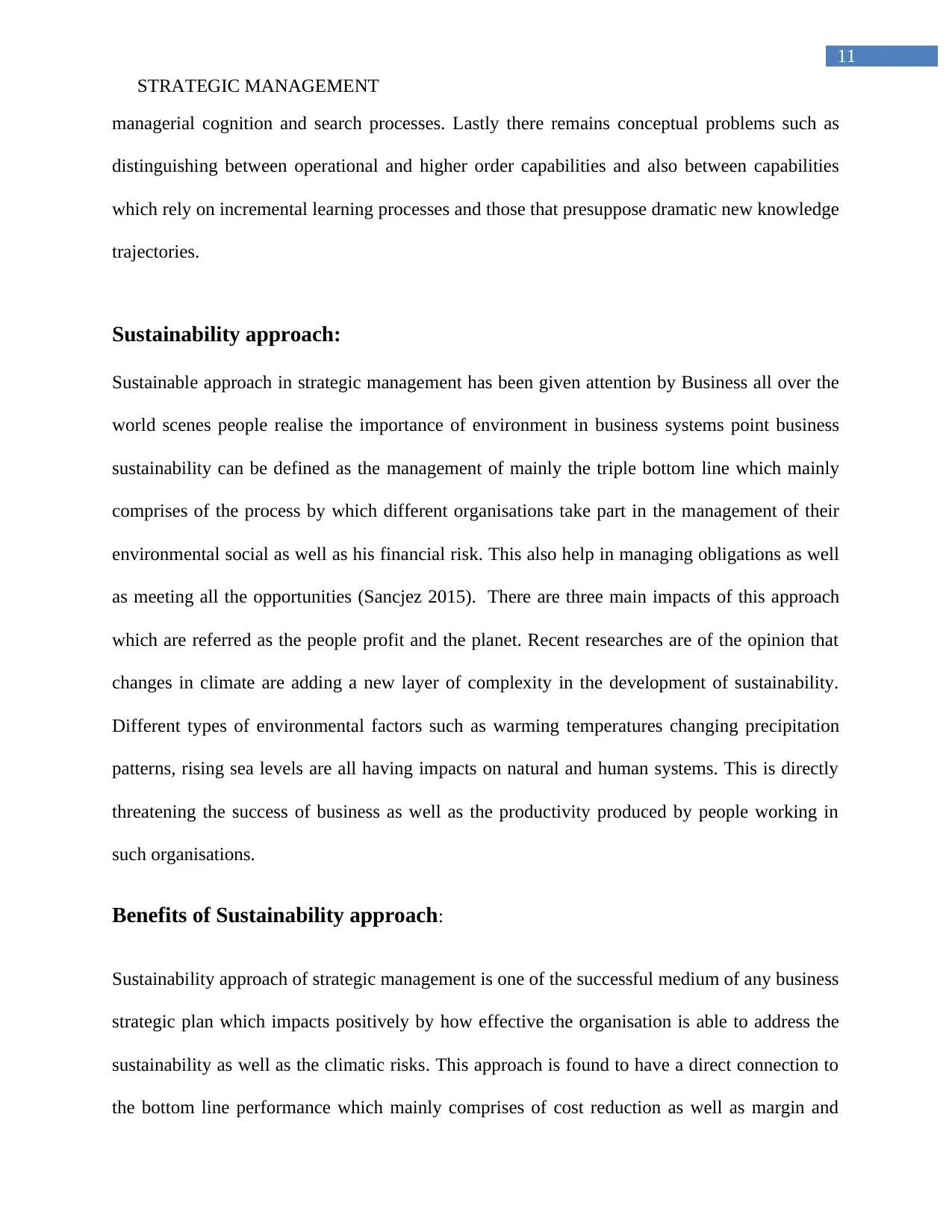
11
STRATEGIC MANAGEMENT
managerial cognition and search processes. Lastly there remains conceptual problems such as
distinguishing between operational and higher order capabilities and also between capabilities
which rely on incremental learning processes and those that presuppose dramatic new knowledge
trajectories.
Sustainability approach:
Sustainable approach in strategic management has been given attention by Business all over the
world scenes people realise the importance of environment in business systems point business
sustainability can be defined as the management of mainly the triple bottom line which mainly
comprises of the process by which different organisations take part in the management of their
environmental social as well as his financial risk. This also help in managing obligations as well
as meeting all the opportunities (Sancjez 2015). There are three main impacts of this approach
which are referred as the people profit and the planet. Recent researches are of the opinion that
changes in climate are adding a new layer of complexity in the development of sustainability.
Different types of environmental factors such as warming temperatures changing precipitation
patterns, rising sea levels are all having impacts on natural and human systems. This is directly
threatening the success of business as well as the productivity produced by people working in
such organisations.
Benefits of Sustainability approach:
Sustainability approach of strategic management is one of the successful medium of any business
strategic plan which impacts positively by how effective the organisation is able to address the
sustainability as well as the climatic risks. This approach is found to have a direct connection to
the bottom line performance which mainly comprises of cost reduction as well as margin and
STRATEGIC MANAGEMENT
managerial cognition and search processes. Lastly there remains conceptual problems such as
distinguishing between operational and higher order capabilities and also between capabilities
which rely on incremental learning processes and those that presuppose dramatic new knowledge
trajectories.
Sustainability approach:
Sustainable approach in strategic management has been given attention by Business all over the
world scenes people realise the importance of environment in business systems point business
sustainability can be defined as the management of mainly the triple bottom line which mainly
comprises of the process by which different organisations take part in the management of their
environmental social as well as his financial risk. This also help in managing obligations as well
as meeting all the opportunities (Sancjez 2015). There are three main impacts of this approach
which are referred as the people profit and the planet. Recent researches are of the opinion that
changes in climate are adding a new layer of complexity in the development of sustainability.
Different types of environmental factors such as warming temperatures changing precipitation
patterns, rising sea levels are all having impacts on natural and human systems. This is directly
threatening the success of business as well as the productivity produced by people working in
such organisations.
Benefits of Sustainability approach:
Sustainability approach of strategic management is one of the successful medium of any business
strategic plan which impacts positively by how effective the organisation is able to address the
sustainability as well as the climatic risks. This approach is found to have a direct connection to
the bottom line performance which mainly comprises of cost reduction as well as margin and
⊘ This is a preview!⊘
Do you want full access?
Subscribe today to unlock all pages.

Trusted by 1+ million students worldwide
1 out of 19
Related Documents
Your All-in-One AI-Powered Toolkit for Academic Success.
+13062052269
info@desklib.com
Available 24*7 on WhatsApp / Email
![[object Object]](/_next/static/media/star-bottom.7253800d.svg)
Unlock your academic potential
Copyright © 2020–2025 A2Z Services. All Rights Reserved. Developed and managed by ZUCOL.





